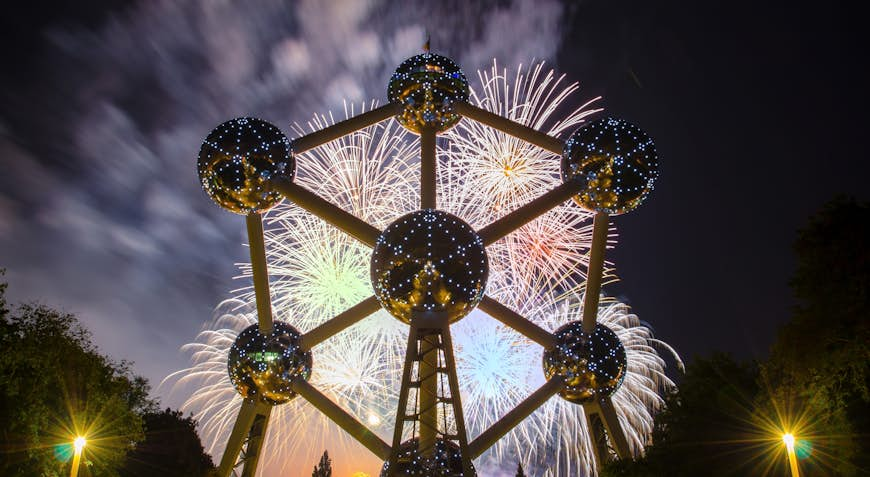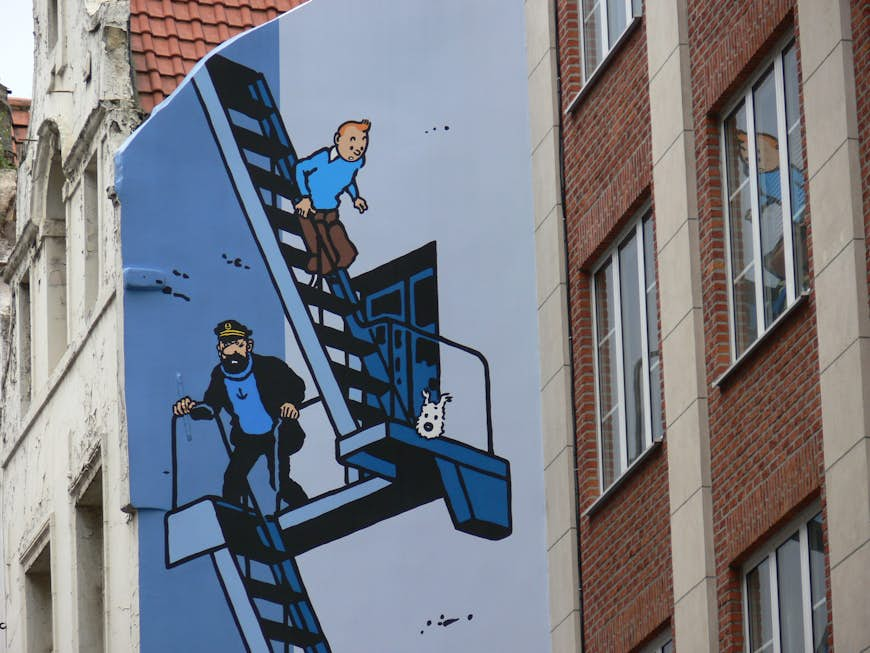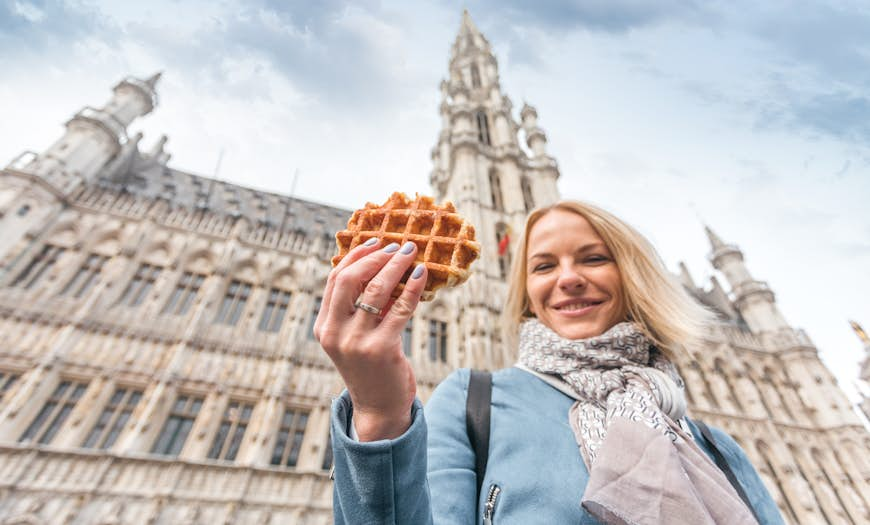Belgium is one of Europe’s most underrated destinations. This unpretentious country – ofter overlooked in favor of such neighbors as France or England – is rich in both food and culture, boasting world-renowned beer, superb street snacks, and sublime sweets. But there’s so much more to discover than just fries and chocolate (though under no circumstances should you miss out on those standbys).
From some of Europe’s oldest architecture, fabled peeing statues, and castles galore to more niche attractions that take travelers off the beaten path, these are 15 of the best things to do in beguiling Belgium.
Stop for a drink – or two – of domestic craft beer at a local pub
Belgian beer is renowned around the world for a reason. The country boasts more than 300 active breweries that make everything from monk-produced Trappist beer to natural-focused gueuze and fruit-forward lambic offerings. Bars and pubs across Belgium usually have a large selection of craft beers available on tap and in bottles – though you’ll want to remember that most Belgian beers have a higher alcohol percentage than you might be used to, with most domestic beers starting at 6% ABV.
The absolute best spot to stop for a drink of Belgian beer is the Délirium Café in Brussels. The no-frills pub offers over 2000 different local and international beers with extremely knowledgeable bartenders who are always more than happy to guide you through the abundance of different local options.
Grab a spot on a terrace and enjoy a coffee
With numerous buildings dating as far back as the thirteenth century, Belgium has some of the oldest architecture in Europe outside of Italy and England. The country takes advantage of its gorgeous and well-preserved buildings and squares with an abundance of outdoor seating, giving travelers and locals a front-row seat to contemplate and appreciate Flemish Renaissance and Renaissance Revival architecture. Markt square in Bruges and the Grand Place in Brussels are two of the most architecturally stunning spots in the country, and both abound with charming sidewalk terraces.
Indulge in fungus-focused fine dining at the Café des Spores in Brussels
Mushroom fiends should consider making a reservation at the Café des Spores in Brussels. This unique French-focused restaurant specializes in all things fungus and mushrooms – all the way down to the dessert menu, which includes items like wood-ear mushrooms with salted caramel figs and cheesecake made with dried porcini mushrooms. The bustling restaurant is spread out across two floors, with tables tucked into intimate nooks and crannies throughout the space.
Treat your sweet tooth to some world-famous Belgian chocolate
It’s an unwritten rule that travelers with even the slightest sweet tooth cannot visit Belgium without stopping for a couple bites of chocolate. Belgian chocolate is justly acclaimed – especially the country’s take on praline and raw chocolate. One of the most popular chocolate makers in the country, Pierre Marcolini offers decadent and high-end sweets and bonbons at its many outposts. Neuhaus is an excellent option for praline lovers; the 165-year-old brand is said to have invented praline and continues to use the oldest praline recipe in the country.
Snack on sweet or savory street waffles
Belgian waffles are another one of those indulgent treats that travelers with a sweet tooth (and even those without one) have to try at least once. Belgian waffles are thicker, with extra-deep pockets that make the perfect vehicle for filling with chocolate and other goodies if you’re so inclined – though they’re just as good with a simple sprinkle of sugar.
You’ll almost always be no more than a stone’s throw away from street vendors selling waffles, especially in city centers and near main tourism hubs. Some of the best waffle vendors to look out for are House of Waffles in Bruges and the Wafelhuis Van Hecke in Antwerp.
Explore the dozens of museums and galleries across the country
Over a thousand museums throughout Belgium range from art and history museums to war memorials and special-interest collections catering to vintage automotive lovers and dinosaur enthusiasts.
Standouts include the Museum of Natural Sciences in Brussels, home to one of the largest collections of dinosaur bones in Europe. More than 30 fully intact iguanodon dinosaur skeletons were discovered in a coal mine at Bernissart in 1878, and have since found a permanent home as the a centerpiece of this museum’s exhibits.
Travelers interested in fashion and style should sashay to the ModeMuseum, a fashion-focused institution in the design capital of Antwerp featuring a whirlwind history of contemporary style with a major emphasis on Belgian designers.
Refuel with Belgian fries – and don’t skimp on the dipping sauces
There’s something about that first bite steaming hot Belgian fries that’ll make you swear off the likes of McDonald’s and Burger King forever. Belgian fries are double-cooked to order, making them extra crispy and satisfyingly starchy. Most fry stands also offer an overwhelming selection of dipping sauces to choose from. We recommend starting with the classic sauce andalouse, a mouthwatering combination of mayonnaise, tomato paste and roasted peppers.
Narrowing down the best spots for fries can easily cause a heated debate; ask any local and they’ll probably tell you something different. Nonetheless, Frit Flagey in Brussels almost always has a line snaking down the block. Don’t let this deter you, though: the line moves fast and the constant flow of traffic means both fries and sauces will always be fresh.
Snap a photo with the Manneken Pis landmark in Brussels
Although it’s slightly off-putting and even inappropriate, the Manneken Pis (the “little pissing man”) in Brussels is one of the most well-known landmarks in the entire country. The bronze fountain sculpture of the peeing boy is supposed to represent the folk humor for which Brussels is famous, and was originally erected in the 1600s (although a replica replaced the original in 1965).
Note that the landmark fountain is only about five minutes from the Grand Place and as such is almost always packed with tourists trying to snap a selfie or group photo. The best time to visit is in the early morning if you want to beat the crowds and examine the statue up close.
Looking for more cheeky fountains and sculptures to add to your selfie bucket list? The Jeanneke Pis is the slightly lesser-known female counterpart, about eight minutes north of the original fountain. The Het Zinneke (Zinneke Pis) was erected in 1998 and depicts a urinating dog.

Visit the wonders of the past and the future at the Atomium
Originally constructed for the 1958 Brussels World’s Fair, the Atomium is both a cultural center and museum that somehow manages to capture both the past and the future at the same time. The 335ft(102m)-high structure was designed to look like an oversized atom, with stainless steel–clad spheres connecting with long aluminum tubes.
While the unique, gravity-defying structure is fascinating to admire from the outside, it’s even more impressive on the inside. The tubes and spheres make up a series of rooms, elevators and walking paths that showcase the history of the Brussels World’s Fair, including the exact displays and attractions that visitors would have seen more than 60 years ago. The highest sphere is home to the Atomium Restaurant. It’s well worth reserving time for a drink by one of the windows, where you’ll have one of the best views of Northern Brussels as well as a bird’s-eye view over the whimsical Mini Europe amusement park below.
Spend the day on the Belgian waterways
Exploring Belgium by boat is one of the most relaxing ways to see the sights and sounds of its cities, and a must-do if you’re planning a visit to Bruges or Ghent. Both towns have picturesque and justly famous canals, with plenty of options available for travelers looking to experience the city by water.
Most boat tours are about half an hour in length and relatively cheap (about €10/US$10.70 per person)/ Same-day, on-location bookings are extremely easy to come across, as long as you don’t mind waiting. We recommend booking in advance to avoid any unnecessary queuing.

Pay a visit to one of Belgium’s thousands of castles and châteaux
With thousands of castles dotted all over the countryside, Belgium has more of them per square foot than any other country in the world – and many are open to receive visitors. The medieval Bouillon Castle in the Ardennes is one of the oldest in the country, dating all the way back to 988. The fortress sits atop the walled city of Bouillon with spectacular views of the canals below.
Get all medieval at the Gravensteen
The Gravensteen is another famous example of medieval Belgian architecture. Located in Ghent, the storied structure was originally the home of the Counts of Flanders and has more recently functioned as a cotton factory, a court and even a prison, before opening to the public as a local attraction. You’ll want to book your spot ahead of time as reservations sell out quickly – and make sure to pick up a headset before setting off on your self-guided tour. The audio tour was written and recorded by a local comedian and is nearly as interesting as the structure itself.
Search for bric-a-brac and knickknacks at an open-air flea market
Belgium has a huge and passionate flea-market and vintage-shopping culture. This literal treasure trove of a country is a bargain- and antique-lovers dream, with most cities boasting open-air markets every weekend and many weekday mornings.
If you can only make time for one shopping excursion, make it Brussels’s Place du Jeu-de-Balle Flea Market, where you’ll find vendors hawking retro trinkets, secondhand designer wares, and antique furniture and home decor every day of the week from morning until late afternoon.
Take a tour of an authentic beguinage
Historically authentic beguinages only exist within Belgium and the Netherlands, which is why visiting one of the architectural complexes is an essential part of a Belgian itinerary. Built to house beguines, religious women who did not take formal vows or retire from society, some of these complexes date to the 13th century, with several having been named Unesco World Heritage Sites. Their exterior architectural ensembles were enclosed by walls or ditches with gates that would open to the public during the day, while the interiors were made up of churches, houses and green spaces.
The Old Saint Elisabeth Beguinage in Ghent is one of the most striking in the country thanks to its colorful facade, car-free cobblestone streets and reputation as the “holy corner.” This space of religious tolerance has three different churches in one square: one Anglican, one Orthodox and one Protestant.

Explore comic-book culture
From Tintin to the Smurfs, Belgium is responsible for some of the most famous comic-book characters of all time. There are plenty of ways to explore the history of comics culture, especially if you’re spending time in Brussels. The free self-guided comic-book walking tour will allow you to explore many of the comic-book murals within the city (we recommend picking up the official comic route handbook at a Brussels tourism office to get the most out of the experience), while the Comics Art Museum pays tribute to the country’s comic-book artists past and present.
Make time to commemorate the world wars
Belgium was heavily involved in both World War I and World War II, and as the seat of NATO and the EU the country continues to take international security and military history seriously. There are dozens of war memorial landmarks and museums throughout the country; the most popular site is Flanders Fields, the battleground at which, staggeringly, that more than a million soldiers from 50 different countries were estimated to have been wounded or killed in action during WWI.
